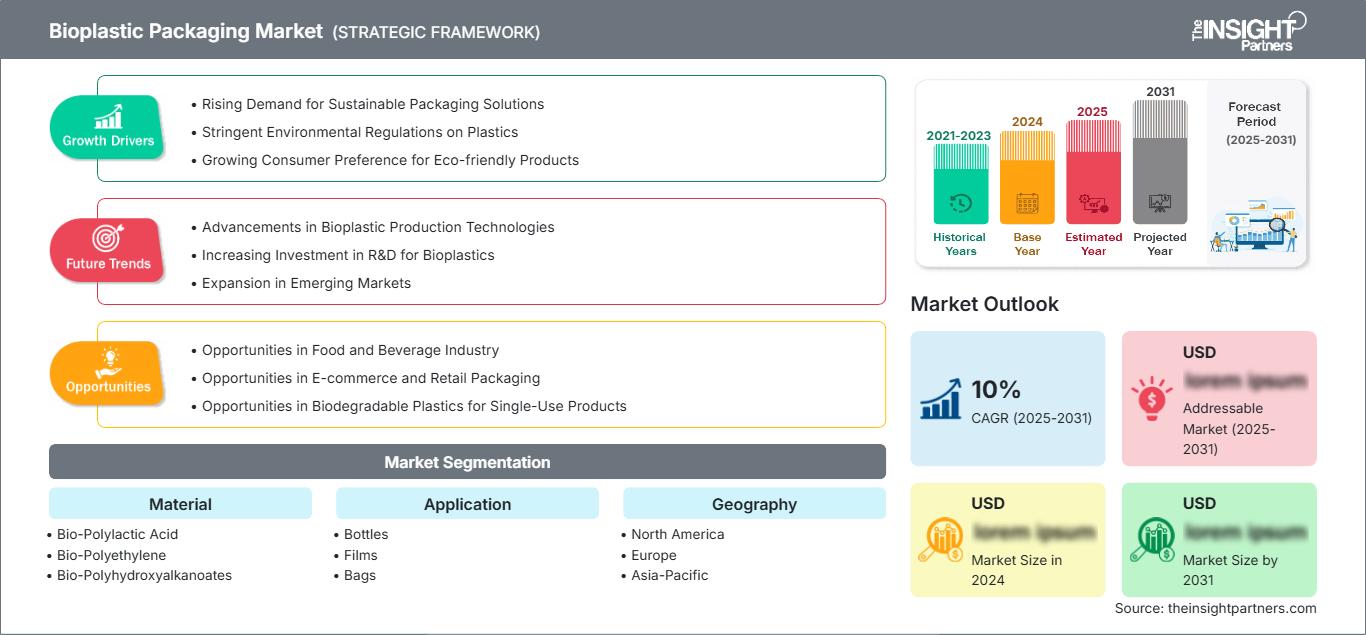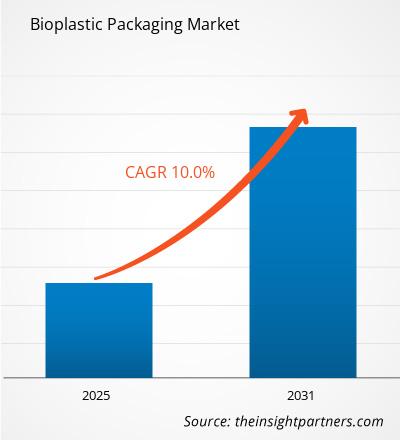Si prevede che il mercato degli imballaggi in bioplastica raggiungerà i 54,24 miliardi di dollari entro il 2031. Si prevede che il mercato registrerà un CAGR del 15,7% nel periodo 2025-2031.
Il rapporto presenta un'analisi basata sui materiali (acido biopolilattico, biopolietilene, biopoliidrossialcanoati, biopolietilene tereftalato e altri). Il rapporto è segmentato per applicazione (flaconi, pellicole, sacchetti, buste e bustine, tazze e vassoi e altri). Il rapporto presenta un'analisi basata sull'uso finale (alimenti e bevande, cosmetici e cura della persona, prodotti farmaceutici e nutraceutici, beni di consumo e altri). L'analisi globale è ulteriormente suddivisa a livello regionale e per i principali paesi. Le dimensioni e le previsioni del mercato a livello globale, regionale e nazionale per tutti i principali segmenti di mercato sono trattate nell'ambito di applicazione. Il rapporto fornisce il valore in dollari per l'analisi e i segmenti sopra indicati. Il rapporto fornisce statistiche chiave sullo stato del mercato dei principali attori e offre tendenze e opportunità di mercato.
Scopo del rapporto
Il rapporto "Bioplastic Packaging Market" di The Insight Partners mira a descrivere il panorama attuale e la crescita futura, i principali fattori trainanti, le sfide e le opportunità. Ciò fornirà spunti a vari stakeholder aziendali, come:
- Fornitori/Produttori di tecnologia: per comprendere le dinamiche di mercato in evoluzione e conoscere le potenziali opportunità di crescita, consentendo loro di prendere decisioni strategiche informate.
- Investitori: per condurre un'analisi completa delle tendenze in merito al tasso di crescita del mercato, alle proiezioni finanziarie di mercato e alle opportunità esistenti lungo la catena del valore.
- Enti di regolamentazione: per regolamentare le politiche e le attività di controllo sul mercato con l'obiettivo di ridurre al minimo gli abusi, preservare la fiducia degli investitori e sostenere l'integrità e la stabilità del mercato.
Materiale di segmentazione del mercato degli imballaggi in bioplastica
- Acido bio-polilattico
- Bio-polietilene
- Bio-poliidrossialcanoati
- Bio-polietilene tereftalato
Applicazione
- Bottiglie
- Film
- Sacchetti
- Bustine e bustine
- Bicchieri e vassoi
Potrai personalizzare gratuitamente qualsiasi rapporto, comprese parti di questo rapporto, o analisi a livello di paese, pacchetto dati Excel, oltre a usufruire di grandi offerte e sconti per start-up e università
Mercato degli imballaggi in bioplastica: Approfondimenti strategici

-
Ottieni le principali tendenze chiave del mercato di questo rapporto.Questo campione GRATUITO includerà l'analisi dei dati, che vanno dalle tendenze di mercato alle stime e alle previsioni.
Fattori di crescita del mercato degli imballaggi in bioplastica
- Crescente domanda di soluzioni di imballaggio sostenibili: la crescente domanda da parte dei consumatori di imballaggi ecocompatibili e sostenibili è un fattore chiave per il mercato degli imballaggi in bioplastica. Con l'aumento dei rifiuti di plastica e delle preoccupazioni ambientali, le bioplastiche, realizzate con risorse rinnovabili come i materiali di origine vegetale, offrono un'alternativa biodegradabile alle plastiche convenzionali. Questa domanda di soluzioni di imballaggio sostenibili sta spingendo le industrie alimentari e delle bevande, della vendita al dettaglio e dei beni di consumo ad adottare imballaggi in bioplastica, stimolando la crescita del mercato.
- Rigorose normative ambientali sulla plastica: i governi di tutto il mondo stanno implementando normative più severe sui rifiuti di plastica, sull'inquinamento e sugli imballaggi non biodegradabili, stimolando la domanda di bioplastiche. Politiche come i divieti sulla plastica e i programmi di responsabilità estesa del produttore (EPR) stanno incoraggiando i produttori a orientarsi verso alternative biodegradabili e compostabili. Le bioplastiche offrono una soluzione praticabile per soddisfare i requisiti normativi, favorendo la crescita del mercato degli imballaggi in bioplastica, poiché le industrie cercano di conformarsi agli standard ambientali.
- Crescente preferenza dei consumatori per prodotti ecocompatibili: si registra un crescente spostamento delle preferenze dei consumatori verso prodotti con un impatto ambientale minimo. I consumatori stanno diventando più consapevoli dell'impatto ecologico degli imballaggi e sono attivamente alla ricerca di prodotti con imballaggi sostenibili. Questa crescente domanda di prodotti ecocompatibili sta spingendo i marchi a scegliere imballaggi in bioplastica come parte dei loro sforzi di sostenibilità, contribuendo alla crescita complessiva del mercato.
Tendenze future del mercato degli imballaggi in bioplastica
- Progressi nelle tecnologie di produzione di bioplastica: i progressi tecnologici nella produzione di bioplastica stanno migliorando la fattibilità e le prestazioni degli imballaggi in bioplastica. Le nuove innovazioni nelle tecnologie di lavorazione stanno migliorando l'efficienza e l'economicità delle bioplastiche, rendendole più competitive rispetto alle plastiche tradizionali. Lo sviluppo di nuovi polimeri di origine biologica, come l'acido polilattico (PLA) e i poliidrossialcanoati (PHA), con maggiore durata e funzionalità, sta guidando la crescita e l'adozione di imballaggi in bioplastica in diversi settori.
- Crescenti investimenti in ricerca e sviluppo per le bioplastiche: gli investimenti in ricerca e sviluppo (R&S) stanno creando nuove opportunità per il mercato degli imballaggi in bioplastica. I produttori si stanno concentrando sullo sviluppo di bioplastiche con proprietà migliorate, come maggiore resistenza, flessibilità e resistenza all'umidità e al calore. Inoltre, gli sforzi di R&S sono mirati all'utilizzo di materie prime più sostenibili e di provenienza locale per le bioplastiche. Queste innovazioni stanno contribuendo ad aumentare la versatilità del mercato e ad ampliarne le applicazioni nel packaging.
- Espansione nei mercati emergenti: le economie emergenti in regioni come Asia-Pacifico, America Latina e Africa stanno assistendo a una rapida crescita nell'adozione di imballaggi in bioplastica. La crescente consapevolezza dell'inquinamento da plastica, unita alle pressioni normative e agli incentivi governativi per gli imballaggi sostenibili, sta incoraggiando le aziende di queste regioni a passare alle bioplastiche. La crescente domanda di soluzioni di imballaggio ecocompatibili nelle regioni in via di sviluppo sta creando significative opportunità di crescita per i produttori di imballaggi in bioplastica.
Opportunità di mercato per gli imballaggi in bioplastica
- Opportunità nel settore alimentare e delle bevande: il settore alimentare e delle bevande offre significative opportunità per il mercato degli imballaggi in bioplastica grazie all'elevata domanda di soluzioni di imballaggio. Le bioplastiche offrono un'opzione sostenibile per il confezionamento di prodotti alimentari, offrendo vantaggi come la biodegradabilità e la compostabilità. Con lo spostamento delle preferenze dei consumatori verso opzioni di imballaggio più sostenibili, le bioplastiche stanno diventando sempre più popolari nel packaging alimentare, creando opportunità di crescita per i produttori che si rivolgono a questo settore.
- Opportunità nell'e-commerce e negli imballaggi al dettaglio: con l'ascesa dell'e-commerce, cresce la domanda di soluzioni di imballaggio sostenibili nella vendita al dettaglio online. Le bioplastiche stanno emergendo come una valida opzione per gli imballaggi per l'e-commerce grazie alle loro caratteristiche ecocompatibili. La crescente attenzione alla riduzione degli sprechi di plastica nei processi di spedizione e imballaggio sta incoraggiando i rivenditori ad adottare alternative bioplastiche, creando un'opportunità redditizia per l'espansione del mercato nel settore dell'e-commerce.
- Opportunità nelle plastiche biodegradabili per prodotti monouso: il mercato delle alternative alla plastica monouso offre opportunità significative per le bioplastiche. Articoli come posate, cannucce e materiali da imballaggio sono tra le plastiche monouso più comuni, contribuendo alla produzione di rifiuti plastici. Poiché governi e consumatori richiedono alternative, le bioplastiche offrono una soluzione biodegradabile per questi prodotti. Questa transizione verso imballaggi e prodotti sostenibili sta guidando la crescita delle bioplastiche nel mercato delle plastiche monouso.
Mercato degli imballaggi in bioplastica
Le tendenze regionali e i fattori che influenzano il mercato degli imballaggi in bioplastica durante il periodo di previsione sono stati ampiamente spiegati dagli analisti di The Insight Partners. Questa sezione illustra anche i segmenti e la geografia del mercato della gestione delle malattie del ritmo cardiaco in Nord America, Europa, Asia-Pacifico, Medio Oriente e Africa, America meridionale e centrale.
Ambito del rapporto sul mercato degli imballaggi in bioplastica
| Attributo del rapporto | Dettagli |
|---|---|
| Dimensioni del mercato in 2024 | US$ XX Billion |
| Dimensioni del mercato per 2031 | US$ 54.24 Billion |
| CAGR globale (2025 - 2031) | 15.7% |
| Dati storici | 2021-2023 |
| Periodo di previsione | 2025-2031 |
| Segmenti coperti |
By Materiale
|
| Regioni e paesi coperti |
Nord America
|
| Leader di mercato e profili aziendali chiave |
|
Densità degli operatori del mercato degli imballaggi in bioplastica: comprendere il suo impatto sulle dinamiche aziendali
Il mercato degli imballaggi in bioplastica è in rapida crescita, trainato dalla crescente domanda degli utenti finali, dovuta a fattori quali l'evoluzione delle preferenze dei consumatori, i progressi tecnologici e una maggiore consapevolezza dei benefici del prodotto. Con l'aumento della domanda, le aziende stanno ampliando la propria offerta, innovando per soddisfare le esigenze dei consumatori e sfruttando le tendenze emergenti, alimentando ulteriormente la crescita del mercato.

- Ottieni il Mercato degli imballaggi in bioplastica Panoramica dei principali attori chiave
Punti di forza
- Copertura completa: il rapporto analizza in modo esaustivo prodotti, servizi, tipologie e utenti finali del mercato degli imballaggi in bioplastica, offrendo una panoramica olistica.
- Analisi degli esperti: il rapporto è redatto sulla base della conoscenza approfondita di esperti e analisti del settore.
- Informazioni aggiornate: il rapporto garantisce la pertinenza aziendale grazie alla copertura di informazioni e tendenze dei dati recenti.
- Opzioni di personalizzazione: questo rapporto può essere personalizzato per soddisfare le esigenze specifiche del cliente e adattarsi in modo appropriato alle strategie aziendali.
Il rapporto di ricerca sul mercato degli imballaggi in bioplastica può quindi contribuire a guidare il percorso di decodificazione e comprensione dello scenario del settore e delle prospettive di crescita. Sebbene possano esserci alcune valide preoccupazioni, i vantaggi complessivi di questo rapporto tendono a superare gli svantaggi.
- Analisi storica (2 anni), anno base, previsione (7 anni) con CAGR
- Analisi PEST e SWOT
- Valore/volume delle dimensioni del mercato - Globale, Regionale, Nazionale
- Industria e panorama competitivo
- Set di dati Excel
Report recenti
Rapporti correlati
Testimonianze
Motivo dell'acquisto
- Processo decisionale informato
- Comprensione delle dinamiche di mercato
- Analisi competitiva
- Analisi dei clienti
- Previsioni di mercato
- Mitigazione del rischio
- Pianificazione strategica
- Giustificazione degli investimenti
- Identificazione dei mercati emergenti
- Miglioramento delle strategie di marketing
- Aumento dell'efficienza operativa
- Allineamento alle tendenze normative






















 Ottieni un campione gratuito per - Mercato degli imballaggi in bioplastica
Ottieni un campione gratuito per - Mercato degli imballaggi in bioplastica